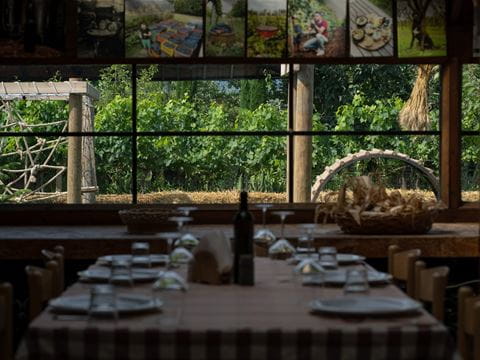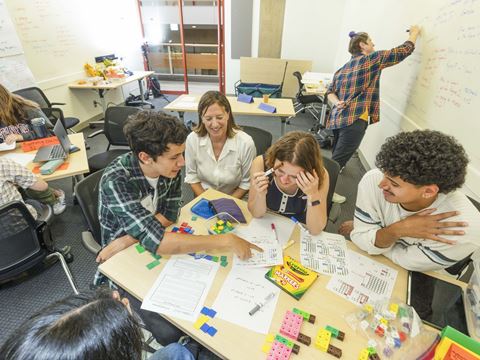Making a Museum Exhibition
Archeology
Museum Studies
North Africa
Written by Julie Weiss
This article offers glimpses not only into the city that came before what is today the Middle East’s largest city, but also into how to construct a museum exhibit.
We encourage reproduction and adaptation of these ideas, freely and without further permission from AramcoWorld, by teachers and students at any level.
—The Editors
The lessons that follow include an introduction, a statement of goals—what students should be able to do by the time they finish—and step-by-step instructions for the activities. Each also includes a link to Common Core standards that the lesson meets. We hope this format will make it easier than ever to use AramcoWorld for your educational goals. Let me know! Send me your comments at [email protected].
—Julie Weiss
“In Fragments from Fustat, Glimpses of a Cosmopolitan Old Cairo”
This article offers glimpses not only into the city that came before what is today the Middle East’s largest city, but also into how to construct a museum exhibit. In this lesson, you will see how the staff of the Oriental Institute in Chicago put together their exhibit about Fustat, what they ended up including in it, and why. By the time you finish the lesson, you will be able to:
- identify the steps used to create the Fustat exhibit
- use the steps you identified to define an exhibit of your own
- explain the value and limitations of different types of objects in a museum exhibit
1. Find the Steps
Read “In Fragments from Fustat, Glimpses of a Cosmopolitan Old Cairo.” As you read, notice that writer Pamela Toler describes the process that led to the exhibit in Chicago about Fustat. Underline or highlight the steps as you come across them in your reading. When you’ve read the entire article, go back and look at your notations. Divide the class into groups of four. With your group, make a list of the steps involved in defining and creating the exhibit. When you’re done, compare your list with the list below.
- Inventory: What objects do we have?
- Theme: What are they about, or what is the story?
- Highlights: What will the audience find most interesting?
- Focus: Taking into account #2, what will be the focus of the exhibit?
- Selection: Which objects will best tell the story?
- Fresh ideas: What will make the exhibit come alive?
- Feedback: How will we know what museum-goers found most interesting?
2. Define your own exhibit.
With your group, take the role of a museum staff 100 years from now, in 2116. You want to put together an exhibit about life 100 years ago, in the early years of the 21st century. For the purposes of this project, use at least five objects, more if you can. Of course, when you think about the objects you have, you aren’t limited by archeological findings. But choose objects that are easily available. Take your time on this, because sometimes creative ideas take a while to come into focus. If possible, have at least two separate meetings with your group to discuss and ultimately answer the questions that will lead to your exhibit.
3. Construct your exhibit.
Your exhibit has a theme that dictates the story you are going to tell. Then the objects help tell the story. Write a paragraph about your exhibit’s theme. In it, explain what its main point will be (you can use the appropriate section of the article to guide you). Then, think about how each object will contribute to telling that story. Actual museum exhibits usually include a caption for each object that identifies the object and explains its significance in the story that the exhibit tells. In order to write your captions, ask yourselves, how does each object you chose contribute to the story you are presenting? Once you’ve written the captions, revisit your statement of the theme. Is it still accurate? Do you need to revise it? Do so, as necessary.
4. Show your exhibit, and evaluate it based on how viewers respond to it.
Now it’s time to show what you’ve done. Display the exhibits you and your classmates have made, and invite other students to see them. What will they think of what you’ve put together? That question – what effect will our work have on those who see it— is one that museum professionals think about a lot. Their credibility is often on the line: Those who financed the exhibit—paid money for it to happen—want to know that they didn’t waste their money. There are many different ways to evaluate how the public responded to the work. The creators of the Fustat show discovered an intriguing way: They saw which iPads’ batteries were depleted. How will you figure out what viewers think about your exhibit? Discuss the question with the members of your group before the showing. Here are a few ideas:
- Develop and give exhibit visitors a survey to get people’s opinions about the show.
- Develop and give exhibit visitors a pre-viewing quiz on the show’s content, and then an “after-viewing” quiz to see what people learned.
- Have viewers record their conversations as they walk through the exhibit; then listen to what they discussed.
- Have some interactive method – like the iPads in Chicago – that can measure audience response.
Whatever method you choose, gather the data and write a short summary of what it tells you about what was most successful about your exhibit and what you might think about doing differently next time.
This lesson meets these Common Core Standards:
RI.9-10.3 Analyze how the author unfolds an analysis or series of ideas or events, including the order in which the points are made, how they are introduced and developed, and the connections that are drawn between them.
W.9-10.2b Develop the topic with well-chosen, relevant, and sufficient facts, extended definitions, concrete details, quotations, or other information and examples appropriate to the audience’s knowledge of the topic.
WHST.9-10.2b Develop the topic with well-chosen, relevant, and sufficient facts, extended definitions, concrete details, quotations, or other information and examples appropriate to the audience’s knowledge of the topic.
Other lessons

Breaking Bread: Using Food As a Teaching Tool
For the Teacher's Desk
Using food as a teaching tool, students widen their global understanding of other cultures while deepening their connection to the world.
The Mostar Bridge Over Troubled Waters: A Case Study in Reconciliation.
History
Language Studies
Europe
Learn how the idioms and metaphors of a bridge destroyed during the Bosnian Civil War express the sentiment of a people.
How To Improve Student Confidence Through Seeing Math Differently
For the Teacher's Desk
Hands-on activities shift math from memorization to exploration—building confidence and curiosity in the classroom.